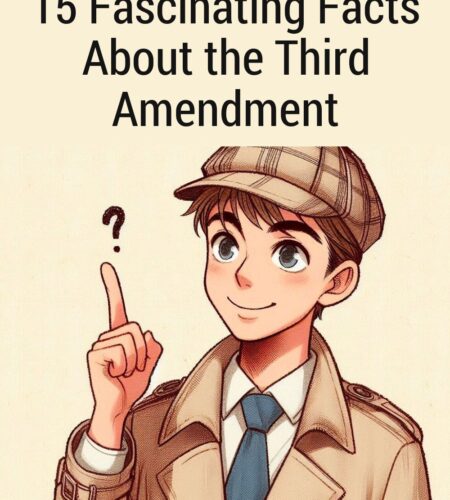The Third Amendment to the United States Constitution is one of the lesser-known amendments, but it holds a unique and important place in American history and legal tradition. It protects citizens from the government’s quartering of soldiers in their homes during peacetime. Let’s delve into 15 intriguing facts about the Third Amendment.
Introduction
The Third Amendment to the United States Constitution is a concise but significant clause that reflects the Founding Fathers’ concerns about personal liberty and the relationship between the government and the people. While it may not be as frequently discussed as other amendments, it remains a cornerstone of individual rights.
Fact 1: A Reaction to British Quartering Acts
Historical Context: The Third Amendment emerged as a reaction to the Quartering Acts, a series of British laws imposed on the American colonies in the 1760s. These acts required colonists to provide housing and supplies to British soldiers during peacetime.
Unwanted Military Presence: The Quartering Acts were deeply resented by the colonists, who viewed them as an intrusion on their personal liberty and a symbol of British oppression.
Fact 2: The Original Text
Concise and Clear: The Third Amendment is one of the shortest and most straightforward amendments in the Bill of Rights. It states, “No Soldier shall, in time of peace be quartered in any house, without the consent of the Owner, nor in time of war, but in a manner to be prescribed by law.”
Protection of the Home: The language is explicit in safeguarding the privacy and sanctity of a person’s home.
Fact 3: Rarely Cited in Legal Cases
Infrequent Litigation: The Third Amendment is one of the least litigated amendments in the Bill of Rights. Legal cases invoking the Third Amendment are exceedingly rare, making it an uncommon subject of courtroom debates.
Modern Relevance: Despite its infrequent appearance in court, the Third Amendment remains relevant as a safeguard against the unwanted presence of the military in private residences.
Fact 4: Peace and War Distinctions
Clear Distinction: The Third Amendment distinguishes between the quartering of soldiers in private homes during peacetime and wartime.
Rules During War: While the amendment permits quartering during war, it specifies that the rules for such quartering must be prescribed by law, ensuring that it is not done arbitrarily.
Fact 5: Protection of Homeowners’ Consent
Emphasis on Consent: The Third Amendment requires the homeowner’s consent for the quartering of soldiers during peacetime. This underscores the importance of individual choice and protection against unwarranted intrusion.
Privacy and Autonomy: This focus on consent reflects the Founding Fathers’ commitment to safeguarding personal privacy and property rights.
Fact 6: The Forgotten Amendment
Overlooked and Underdiscussed: The Third Amendment is often referred to as the “forgotten amendment” because of its limited prominence in public discourse and legal circles.
Rare References: While the First and Second Amendments receive frequent attention and debate, the Third Amendment remains in the background, although it still plays a crucial role in upholding individual freedoms.
Fact 7: Influential Legal Precedent
Engblom v. Carey (1982): One of the few notable cases invoking the Third Amendment is Engblom v. Carey, a legal action in which New York prison guards sued the state after being required to live in the prison’s residential buildings.
Recognition of the Third Amendment: The case ultimately recognized that the Third Amendment applies not only to private residences but also to state-owned or operated housing.
Fact 8: Relevance to Contemporary Issues
Government Surveillance Concerns: In an age of increasing concern about government surveillance, the Third Amendment remains pertinent, as it underscores the importance of protecting personal living spaces from unwanted intrusions.
Modern-Day Privacy Debates: While the Third Amendment primarily deals with military quartering, it inspires discussions on broader issues of privacy and government intrusion into private lives.
Fact 9: Its Relationship with the Second Amendment
Similar Historical Context: The Third Amendment shares a historical context with the Second Amendment. Both amendments reflect the Founding Fathers’ concerns about government overreach and the need for an armed populace.
Defense of Individual Liberties: The Third Amendment’s protection of the home complements the Second Amendment’s emphasis on the right to bear arms in defense of one’s home.
Fact 10: The Influence of John Adams
John Adams’s Advocacy: John Adams, a Founding Father and the second President of the United States, was a vocal advocate for the Third Amendment.
His Role in Massachusetts: Adams played a significant role in shaping Massachusetts’ state constitution, which was among the first to include protections against quartering of soldiers.
Fact 11: A Legacy of Anti-Quartering Provisions
State Constitutions: Many state constitutions include provisions similar to the Third Amendment, underscoring the widespread commitment to protecting personal privacy.
A Parallel Theme: The emphasis on safeguarding homes from unwarranted military intrusion is a consistent theme in American legal and constitutional history.
Fact 12: Its Connection to the Fourth Amendment
Parallel Protections: The Third Amendment shares similarities with the Fourth Amendment, which protects against unreasonable searches and seizures.
Protection from Intrusions: Both amendments are rooted in a commitment to shielding individuals from unwanted intrusions into their personal space, whether by soldiers or government agents.
Fact 13: A Shield Against Civil Unrest
Protection from Military Overreach: The Third Amendment is seen as a safeguard against the use of the military to quell civil unrest or enforce government authority within the confines of private homes.
Historical Precedents: In times of conflict, governments have used military quarters as centers of control and surveillance, making the Third Amendment’s protections highly relevant.
Fact 14: The Supreme Court’s Limited Involvement
Supreme Court Rulings: The U.S. Supreme Court has had limited involvement with cases invoking the Third Amendment, due to its rare litigation.
Engblom v. Carey: The Engblom v. Carey case remains one of the few instances in which the Supreme Court addressed Third Amendment issues.
Fact 15: The Third Amendment’s Symbolic Value
Symbol of Liberty: While the Third Amendment is not frequently cited in court, it holds symbolic value as a testament to the Founding Fathers’ commitment to protecting individual liberties.
A Pillar of the Bill of Rights: It is one of the original ten amendments in the Bill of Rights and, as such, reflects the principles of freedom and autonomy at the core of American democracy.
Conclusion
The Third Amendment to the United States Constitution may not be as prominent as the First or Second Amendments, but it carries profound significance in the realm of individual freedoms and privacy. It serves as a reminder of the Founding Fathers’ concerns about the intrusion of government or military forces into the private homes of citizens. In today’s world, where privacy and personal space are of paramount importance, the Third Amendment’s protections remain vital to preserving the sanctity of the home and upholding personal liberties.
Subscribe to our email newsletter to get the latest posts delivered right to your email.





Comments